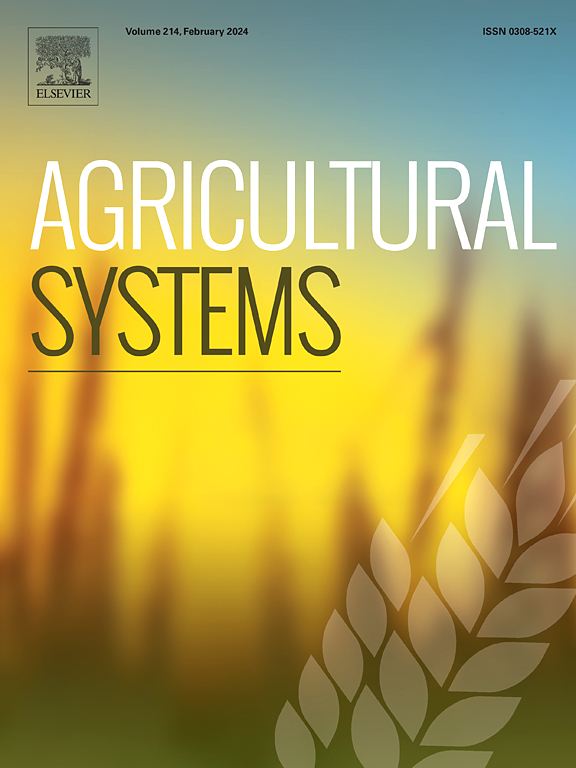大规模种植园咖啡收获的空间轨迹:生态和管理驱动因素及影响
IF 6.1
1区 农林科学
Q1 AGRICULTURE, MULTIDISCIPLINARY
引用次数: 0
摘要
CONTEXTC 咖啡是在不同的管理制度和生产规模下生产的,被归类为 "生产综合症"。资本主义综合症 "的特点是大规模和高密度的种植农场,这可能会促进咖啡叶锈病等植物病原体的发展。采收动态也受生产综合征的影响,并产生可能导致病原体在种植园之间和内部扩散的空间轨迹。目标描述并分析两个大规模资本主义种植园(一个有机种植园和一个传统种植园)中咖啡收割机的日常空间移动,并系统分析可能解释空间移动轨迹差异的驱动因素。方法我们利用状态空间模型记录并分析了收割机的空间移动。然后,我们构建了一棵采摘动态驱动树,其中包含与环境、咖啡生物学以及采摘者或先前研究中报告的管理方面有关的定性变量:1)当树上有浆果时,采摘者会留在咖啡行或附近区域(采集状态;94-98 % 的采摘步骤);2)当树上没有浆果时,采摘者会在采摘地点移动更长的步骤或移动到其他区域(搜索状态;2-6 % 的采摘步骤)。与传统种植园相比,有机种植园的 "搜索状态 "具有更长尾的步长分布,因此每个工人访问的区域明显更大(p <0.05)。这可能与较低的植株间成熟比例或较小的采收地点("pantes")/采收工人数量有直接关系。采摘树的数量可能受到果实量或咖啡品种等因素的影响。这些结果构成了对采收轨迹的初步分析,并强调了可减少病原体人为传播潜在影响的做法,如通过减少每天工作时间缩短采收轨迹,或避免在成熟季节末期采收,因为此时只有少数果树结出浆果,采收人员不得不进行中长距离采收。这就需要对咖啡进行有机管理,以预防疾病并保证工人的公正和安全条件。本文章由计算机程序翻译,如有差异,请以英文原文为准。

Spatial trajectories of coffee harvesting in large-scale plantations: Ecological and management drivers and implications
CONTEXT
Coffee is produced under different management systems and scales of production categorized as Syndromes of Production. The “Capitalist Syndrome” is characterized by large-scale and high-density planting farms that may promote the development of plant pathogens like coffee leaf rust (CLR). Harvesting dynamics are also affected by the syndrome of production and generate spatial trajectories that could contribute to the dispersal of pathogens across and within plantations. However, these spatial trajectories have not yet been described, nor their relationship with the syndrome of production, and even less its potential ecological implications for pathogen dispersal.
OBJECTIVE
Describe and analyze the daily spatial movement of coffee harvesters in two large-scale capitalist plantations, an organic and a conventional plantation, and systematize the drivers that might explain the differences in the spatial trajectories.
METHODS
Using State-Space Models, we recorded and analyzed the spatial movements of harvesters. We then constructed a driver tree for harvest dynamics, which incorporated qualitative variables related to the environment, coffee biology, and management aspects reported by the harvesters or in previous studies.
RESULTS AND CONCLUSIONS
The model differentiated two kinds of movements: 1) when trees have berries, harvesters remain in the coffee rows or areas nearby (Collect state; 94–98 % of the steps); 2) when not, harvesters make longer steps within the harvesting location or move to another area (Search state; 2–6 % of the steps). In the organic plantation, the Search state had a longer-tailed step-length distribution than in the conventional plantation, resulting in a significantly larger visited area per worker (p < 0.05). This might be directly related to the lower interplant ripening percentage or smaller harvesting locations (“pantes”) per number of harvesters. The number of harvested trees might be affected by the fruit load or the coffee variety, among others. Harvesting movements that explore a larger area, either by visiting more plants or by changing locations on the same day, could create more foci of CLR infection across the plantation.
SIGNIFICANCE
These results constitute an initial analysis of harvesting trajectories and highlight practices that can reduce the potential impact of human dispersal of pathogens, like shorter harvesting trajectories by working fewer hours a day or avoiding harvesting at the end of the maturation season when few trees have berries and harvesters have to travel medium to long distances. This calls for organic coffee management that could prevent diseases and guarantee just and safe conditions for workers.
求助全文
通过发布文献求助,成功后即可免费获取论文全文。
去求助
来源期刊

Agricultural Systems
农林科学-农业综合
CiteScore
13.30
自引率
7.60%
发文量
174
审稿时长
30 days
期刊介绍:
Agricultural Systems is an international journal that deals with interactions - among the components of agricultural systems, among hierarchical levels of agricultural systems, between agricultural and other land use systems, and between agricultural systems and their natural, social and economic environments.
The scope includes the development and application of systems analysis methodologies in the following areas:
Systems approaches in the sustainable intensification of agriculture; pathways for sustainable intensification; crop-livestock integration; farm-level resource allocation; quantification of benefits and trade-offs at farm to landscape levels; integrative, participatory and dynamic modelling approaches for qualitative and quantitative assessments of agricultural systems and decision making;
The interactions between agricultural and non-agricultural landscapes; the multiple services of agricultural systems; food security and the environment;
Global change and adaptation science; transformational adaptations as driven by changes in climate, policy, values and attitudes influencing the design of farming systems;
Development and application of farming systems design tools and methods for impact, scenario and case study analysis; managing the complexities of dynamic agricultural systems; innovation systems and multi stakeholder arrangements that support or promote change and (or) inform policy decisions.
 求助内容:
求助内容: 应助结果提醒方式:
应助结果提醒方式:


